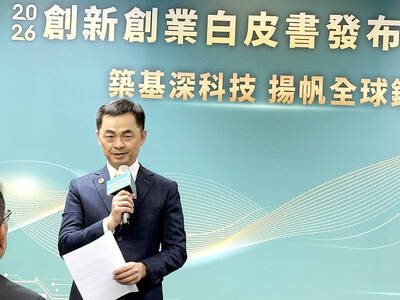China’s state-backed National IC Investment Fund is to shift its investment focus to the Chinese chip designing sector from the chip manufacturing sector, as Beijing is trying to boost China’s role in the global semiconductor industry, TrendForce Corp (集邦科技) said yesterday.
The fund has committed to investing about 70 billion yuan (US$10 billion) in China’s semiconductor industry since its creation lst year, according to TrendForce.
About 60 percent of the investments have been allocated to building semiconductor wafer fabs, the researcher said in the latest report.
China’s Tsinghua Unigroup Ltd (清華紫光), Apex Microelectronics (珠海艾派克微電子) and ZXIC (深圳中興微電子), a chip design unit of ZTE Corp (中興), have received financial support from the fund, TrendForce said.
Overall, Chinese and foreign semiconductor companies in China have invested 480 billion yuan in wafer fabs from the beginning of last year to this month, the report said.
About 86.5 percent of the amount, or 435 billion yuan, came from state-backed funds, including the National IC Fund and local funds for IC ventures, TrendForce said.
As a result, China’s 12-inch wafer capacity is expected to surge from 373,000 wafers per year to 620,000 wafers per year over the next three years, it said.
The fund is to shift its focus to China’s fabless chip design and chip packaging and testing sectors from chip manufacturing, TrendForce said.
The fund would inject capital into Chinese design houses to improve their innovative capabilities and to help them clinch overseas merger-and-acquisition deals, it said.
“The new capital injection will increase market competition. Ultimately, China will reduce the technological gap between itself and Taiwan, not to say the gap is already shrinking rapidly,” Lin Jian-hong (林建宏), a semiconductor analyst with TrendForce, said on the telephone.
“To fend off competition from Chinese rivals, Taiwanese firms need to deepen the partnership with their customers,” Lin said.
China’s chip designers have seen their total global market share surge to about 10 percent this year from 5 percent five years ago, according to TrendForce’s statistics.
Taiwan holds about 18 percent to 20 percent, the researcher said.
The number of China’s fabless IC design companies almost doubled this year to 1,362, among them Hisilicon Technologies Co (海思半導體) and Spreadtrum Communications Inc (展訊), compared with 736 last year, according to TrendForce.
The number is about 13 times of the number in Taiwan, where about 100 chip designers operate.

CHIP RACE: Three years of overbroad export controls drove foreign competitors to pursue their own AI chips, and ‘cost US taxpayers billions of dollars,’ Nvidia said China has figured out the US strategy for allowing it to buy Nvidia Corp’s H200s and is rejecting the artificial intelligence (AI) chip in favor of domestically developed semiconductors, White House AI adviser David Sacks said, citing news reports. US President Donald Trump on Monday said that he would allow shipments of Nvidia’s H200 chips to China, part of an administration effort backed by Sacks to challenge Chinese tech champions such as Huawei Technologies Co (華為) by bringing US competition to their home market. On Friday, Sacks signaled that he was uncertain about whether that approach would work. “They’re rejecting our chips,” Sacks

NATIONAL SECURITY: Intel’s testing of ACM tools despite US government control ‘highlights egregious gaps in US technology protection policies,’ a former official said Chipmaker Intel Corp has tested chipmaking tools this year from a toolmaker with deep roots in China and two overseas units that were targeted by US sanctions, according to two sources with direct knowledge of the matter. Intel, which fended off calls for its CEO’s resignation from US President Donald Trump in August over his alleged ties to China, got the tools from ACM Research Inc, a Fremont, California-based producer of chipmaking equipment. Two of ACM’s units, based in Shanghai and South Korea, were among a number of firms barred last year from receiving US technology over claims they have

BARRIERS: Gudeng’s chairman said it was unlikely that the US could replicate Taiwan’s science parks in Arizona, given its strict immigration policies and cultural differences Gudeng Precision Industrial Co (家登), which supplies wafer pods to the world’s major semiconductor firms, yesterday said it is in no rush to set up production in the US due to high costs. The company supplies its customers through a warehouse in Arizona jointly operated by TSS Holdings Ltd (德鑫控股), a joint holding of Gudeng and 17 Taiwanese firms in the semiconductor supply chain, including specialty plastic compounds producer Nytex Composites Co (耐特) and automated material handling system supplier Symtek Automation Asia Co (迅得). While the company has long been exploring the feasibility of setting up production in the US to address

OPTION: Uber said it could provide higher pay for batch trips, if incentives for batching is not removed entirely, as the latter would force it to pass on the costs to consumers Uber Technologies Inc yesterday warned that proposed restrictions on batching orders and minimum wages could prompt a NT$20 delivery fee increase in Taiwan, as lower efficiency would drive up costs. Uber CEO Dara Khosrowshahi made the remarks yesterday during his visit to Taiwan. He is on a multileg trip to the region, which includes stops in South Korea and Japan. His visit coincided the release last month of the Ministry of Labor’s draft bill on the delivery sector, which aims to safeguard delivery workers’ rights and improve their welfare. The ministry set the minimum pay for local food delivery drivers at